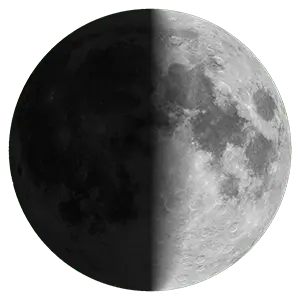
The Moon is always half-lit by the sun (except during a lunar eclipse). The side of the Moon facing the Sun appears bright because of reflected sunlight, and the side of the Moon facing away from the Sun is dark. Our perspective on the half-lit Moon changes as the Moon orbits Earth. When the side nearest to us is fully lit, we call this a full Moon. When the far side is fully lit and the near side is dark, we call this a new Moon. When we see other phases, we are looking at the division between lunar night (the dark part) and day (the bright part).
There are four major lunar phases: the New Moon, the First Quarter, the Full Moon, and the Last Quarter (also known as the Third or Final Quarter). There are also four minor phases: waxing crescent, waxing gibbous, waning gibbous, and waning crescent.
The 8 moon phases in order are new moon, waxing crescent, first quarter, waxing gibbous, full moon, waning gibbous, last quarter, and waning crescent. The Moon displays these eight phases one after the other as it moves through its cycle each month. It takes 27 days for the Moon to orbit Earth. That means the Moon's cycle is 27 days long.
This is the first and invisible phase of the Moon, with the illuminated side of the Moon facing the Sun and the night side facing the Earth.
This is the second phase of the Moon. It occurs when the illuminated half of the Moon faces mostly away from Earth, with only a tiny portion visible to us from our planet. It grows daily as the Moon’s orbit carries the Moon’s dayside farther into view. Every day, the Moon rises a little bit later.
The First Quarter is the third lunar phase. The Moon is a quarter of the way around its orbit and you see half of its illuminated side. That’s why sometimes it is also termed as Half Moon. A first quarter moon rises around noon and sets around midnight. It’s high in the sky in the evening and makes for excellent viewing.
This is the fourth phase of the Moon. The waxing gibbous phase is between a Half Moon and Full Moon and waxing means that the Moon is getting bigger and bigger. This phase of the Moon can be seen from late afternoon and most of the night (from 3 pm to 3 am).
The Full Moon is the fifth lunar phase. The Moon appears fully illuminated from Earth's perspective. This occurs when Earth is located between the Sun and the Moon. A Full Moon rises around sunset and sets around sunrise.
This is the sixth phase of the Moon. The waning gibbous phase is between a Full moon and a Half moon and it means that the Moon is getting smaller and smaller. A Wanning Gibbous Moon rises around 9 pm and sets around 9 am.
The Third Quarter (sometimes called as Last Quarter) is the seventh lunar phase. The Moon looks like its half illuminated from the perspective of Earth, but you’re really seeing just half of the Moon, that’s illuminated by the Sun, so it’s a quarter. You can see this phase at from midnight to early morning (6 am).
This is the eighth and also the final phase of the Moon. The Moon is nearly back to the point in its orbit where its dayside directly faces the Sun, and all that we see from our perspective is a thin curve. The Wanning Crescent Moon can be seen from pre-dawn to early afternoon.
Half Moon is used to mean the first- and third-quarter moons, while the term quarter refers to the extent of the Moon's cycle around the Earth, not its shape. So a Half Moon is when only half of the Moon’s surface facing the Earth is lit by light from the Sun.
The best time to go stargazing is around the New Moon, when there is no Moon in the sky. Therefore, both the morning and evening sky are moon-free and great for stargazing.
Yes, everyone sees the same phases of the Moon. People north and south of the equator do see the Moon’s current phase from different angles, though. If you traveled to the other hemisphere, the Moon would be in the same phase as it is at home, but it would appear upside down compared to what you're used to!